The Lud Church project
Documents
Click on the links for two cuttings from The Leek Post and Times about the association of the medieval poem Sir Gawain and the Green Knight
This link is to a cutting from the Leek Post and Times from 1958 concerning the poem Sir Gawain and the Green Knight
The following paper can be downloaded as a pdf file for printing.
Lud’s church – Place of wonder or place of worship?
Lud Church or Lud’s church is in the parish of Leekfrith, near Leek, in Staffordshire. (O.S. map ref. SJ987656) It is about 100 metres long, 15 metres deep and at places 3 metres wide. Our group wanted to find out if there was any evidence for the fact that Lud church had been used for worship in the past.
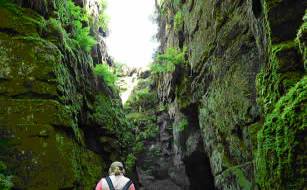
In June 2009, two members of Leekfrith Bygone Days, walked to Lud’s church to make photographic records of the site. The light was excellent and the greenery, being damp, shone against the rock. Some people talk of a sense of place, as in a church, others of foreboding or an unexplained menace, on entering Lud’s Church. In June the sun was at its highest, but there was still an atmosphere on entering the chasm in the grit stone rock. This was enhanced by the dampness, the lush vegetation overhead and all around, and the many stories told about it locally.
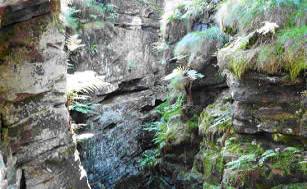
It is certainly a place of wonder but has it ever been used as a place of worship?
Tales are told of links with the Celts, Vikings, The Green Knight, possibly the monks of Dieulacres Abbey (just 6 miles away) and the Lollards, but can any of these stories be substantiated?
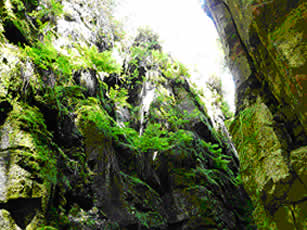
In Miller’s “Olde Leeke” [1] it states that Hen Cloud and the Roches are “rich with Druidical and sacrificial altars of stone, cromlechs (prehistoric stone structures), rocking stones and weird caverns”. We wondered if it was possible that the names of Lud’s church and Lud church have been passed down because of a connection with ancient methods of worship.
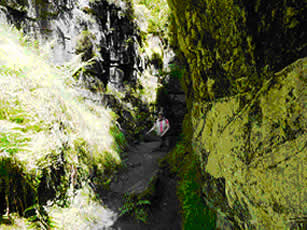
The Celts
Some people locally have suggested that the name comes from Celtic traditions.
According to “Kelly’s directory for Staffordshire” (1904), [2]
the name Cloud (Hen Cloud and Five Clouds being local place names) comes from the Cymro-Celtic “clawdd” meaning a height.
Michael Raven, in his “Guide to Staffordshire” [3] refers to nearby Hanging Stone and the legend that, in prehistoric times, it was used to make sacrifices to the goddess Dana (Danu).
Ludd (Nuada or Nudd) was the Celtic god of healing. He was reputed to use his sword to cut his enemies in half. According to Celtic mythology, when Nuada was killed, Lugh became the leader of the Tuatha de Danaan, the term used for those who were descended from the goddess Danu. The god Lugh (Ludd) was worshipped in Ireland as a deity of the sun. The name means “shining one”. However, at this time we apparently have no evidence of a link.
The Vikings
Miller [4] writes, in 1900, of a tale written a century before about Ludd, the Viking. It was believed that Ludd landed in Lincolnshire, worked his way across to the Derwent valley and then to the Dove valley. At Thirkelow they made a barrow over the grave of Thirkil, one of their men, and then hunted boar at Wildboarclough. As it was the time of year to offer human sacrifices to Thor and Woden, when they came to the gorge in the rocks, they used it to kill their prisoners and praise their god Thor.
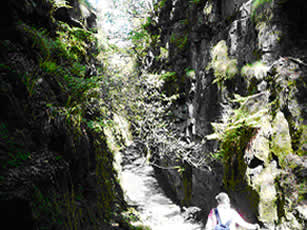
The Monks of Dieulacres Abbey and the Green Chapel
It has also been suggested that Lud’s church was the inspiration for the Green Chapel in “Sir Gawain and the Green Knight”, a late 14th century poem, written in the North West Midland dialect of Middle English.
In 1958 Ralph Elliot wrote in The Times that it was his belief that the poem was written by a monk from our local abbey of St Mary and St Benedict of Dieulacres.
http://www.leekfrithhistory.org.uk/PDF%20files/Sir%20Gawain%201958%20Times.pdf
Simon Armitage writes [5]
“The diction of the original tells us that its author was, broadly speaking, a northerner. Or we could say a midlander. The linguistic epicenter of the poem has been located in the area of the Cheshire–Staffordshire-Derbyshire border.”
In the BBC4 programme, “Sir Gawain and the Green Knight” (2009) Simon visits Lud’s church as described in this article in The Times
He says "Several locations have been suggested for the site of the Green Chapel, but for me it has to be Lud's Church, near Gradbach, Staffordshire. Like an English version of the Grand Canyon, it's a fissure in the rocks that reaches backward into the hill and is overgrown on all sides with luminous green moss. The clammy air feels as if it hasn't been refreshed for several centuries, and it's the perfect setting for the poem's finale, as the terrified Gawain calls into the echoing cavern and hears above him the grinding of a giant axe...."
http://entertainment.timesonline.co.uk/tol/arts_and_entertainment/books/article6335669.ece?token=null&offset=12&page=2
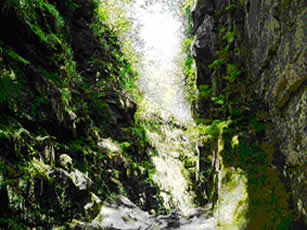
The Lollards
The first recognised critics of the established church since the Fifth Century were The Lollards, according to historian, Mike Ibeji.
http://www.bbc.co.uk/legacies/myths_legends/england/stoke_staffs/article_2.shtml
"They were founded by John Wyclif, in the 1370s, and quickly found themselves victims of persecution from the Catholic Church, and the monarchy. In 1410, Henry IV gave royal assent to a statute which legitimised the burning of heretics, 'De haeretico comburendo'; the Lollards were victims of this aggression, because of their radical policies. Their belief that the Catholic Church was corrupt threatened the privileged position enjoyed by the priests and monasteries of England."
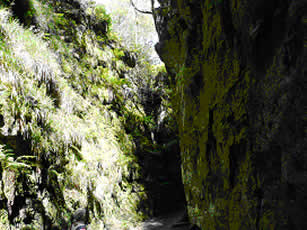
According to local legend, a group of Lollards, led by Walter de Lud-Auk a preacher from the 1400s, hid in the chasm and worshipped in “Nature’s chapel”, hidden from persecution. The BBC website
http://www.bbc.co.uk/legacies/myths_legends/england/stoke_staffs/article_1.shtml
retells the story from “Swythamley and its Neighbourhood” [6] recounted in the 19th cent.
Walter’s grand-daughter, Alice de Lud-Auk was singing a hymn when the service was interrupted by a group of royal soldiers who had come to break up the illegal religious service. During the scuffle Alice was mortally wounded and the rest were arrested.
We are led to believe that Alice was buried under an oak tree at the entrance to the chapel.
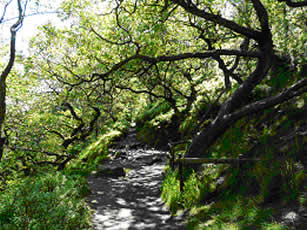
Sir Philip Brocklehurst of Swythamley, along with others, helped to romanticize the story
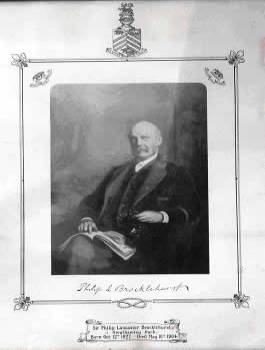
In “Leek: Leekfrith”, a history of the county of Staffordshire [7] it states that
"About 1862 the landowner, Philip Brocklehurst of Swythamley, in Heaton, placed a ship's figurehead in the form of a woman at the entrance of the ravine. It was apparently intended to commemorate the supposed martyrdom of the daughter of the Lollard preacher, and it was still there in 1914."
This old photograph , kindly shared with us by Karen Turner, shows visitors to Lud church, possibly during the first decade of the 20th century. The figure has been moved to a niche in the rock face. The photograph has been in local ownership for at least three generations. At one time a charge was made for visitors to this site of wonder and postcards were available at the beginning of the 1900s. Copies can be seen on our website
http://www.leekfrithhistory.org.uk/Lud%20Church%20project%20photos.html
and show that the figure was in the niche between 1906 and 1935.
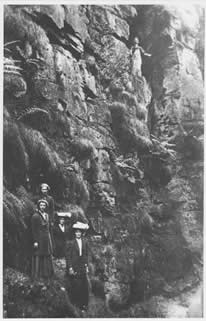
The following picture was taken in 1930. There have been reports from the 1960's of the figurehead rotting in the mud at the bottom of the chasm. So in all it was there for about 90-100 years.
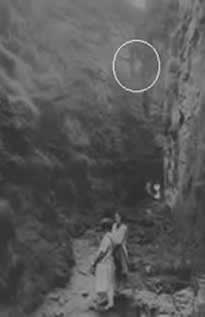
Sir Philip certainly appeared to encourage tourism in this area and a few good stories certainly help, but that does not make the legend true.
It has been fascinating trying to find the background to all these possibilities but we still have no proof as yet. Perhaps you . . . or the rocks . . . know otherwise.
Sources
Page 2
[1] “Olde Leeke” ed. M H Miller vol. 2 p82, printed at “The Times” office, Leek. View at Leek library.
[2] “Kelly’s Directory of Staffordshire” 1904. View at Leek library.
[3] “A Guide to Staffordshire and the Black Country” Michael Raven, 2004,
ISBN0906114330. This can be borrowed from Leek library.
Page 3
[4] “Olde Leeke”, ed. M H Miller, Vol. II. Leek, Staffs. 1900
[5] “Sir Gawain and the Green Knight” p.(vi) Simon Armitage. Pub. 2007 by Faber and Faber. ISBN978-0-571-22328-2
Page 4
[6] “Swythamley and its Neighbourhood” P L Brocklehurst. (Private print 1874)
Page 6
[7] “Leek: Leekfrith, A History of the County of Stafford”: Volume 7: Leek and the Moorlands (1996), pp. 191-202. URL:
http://www.british-history.ac.uk/report.aspx?compid=22915
The footnote refers to A History of the Ancient Parish of Leek in Staffordshire (first and second editions, 1862 and 1883) J. Sleigh. To be viewed in Leek library and the William Salt Library in Stafford.
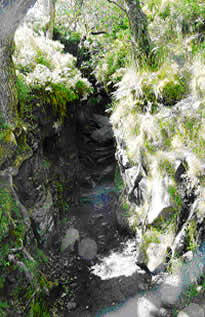
Old Postcards of Lud Church
These are links to old postcards of Lud Church from the early part of the 20th century. The files are very big as I have not reduced them. It seems a shame to loose the detail. They may take a while to download.
Valentine card
Black and white postcard
Sepia postcard from 1918
Roma series postcard from 1906
Black and white from 1935
